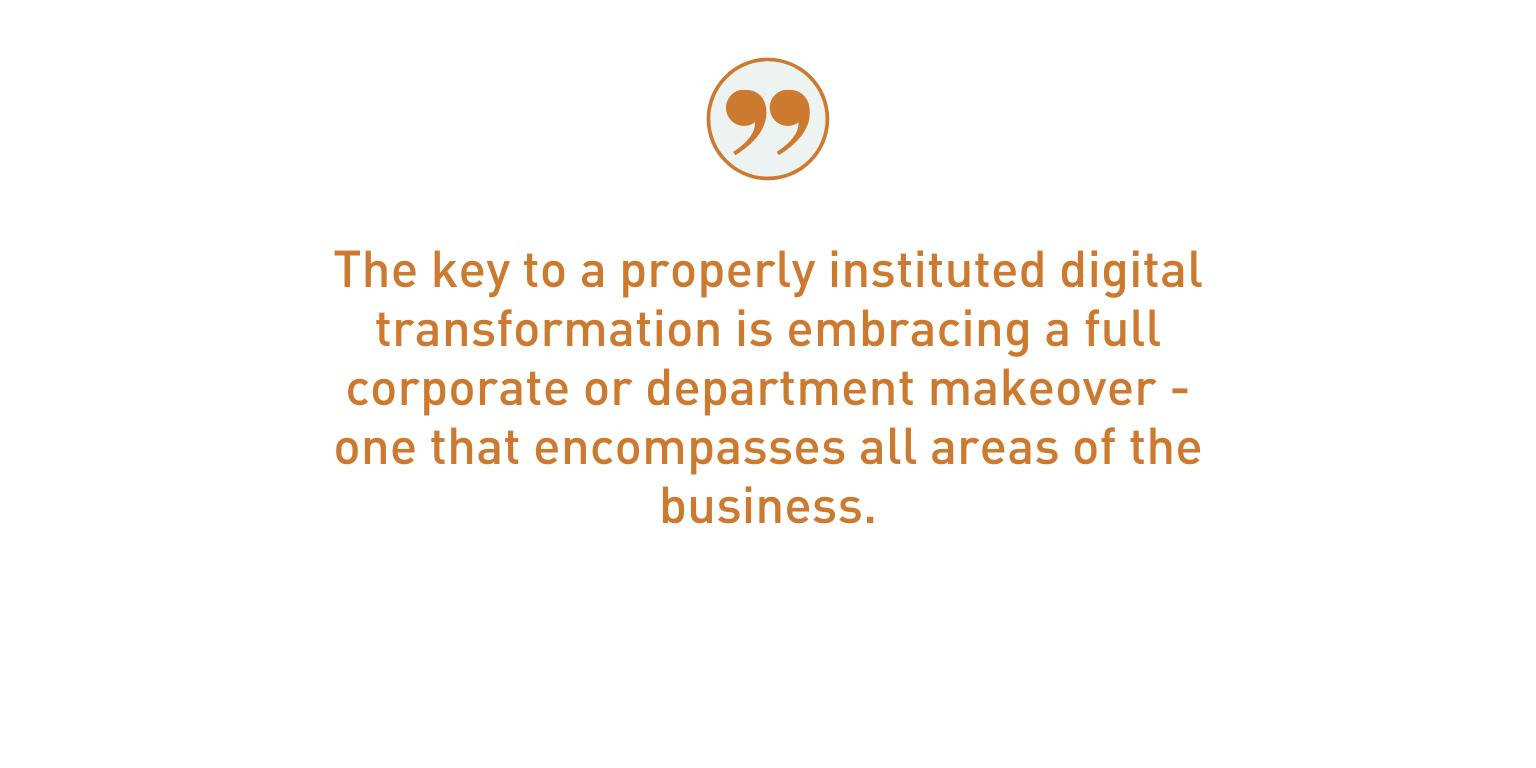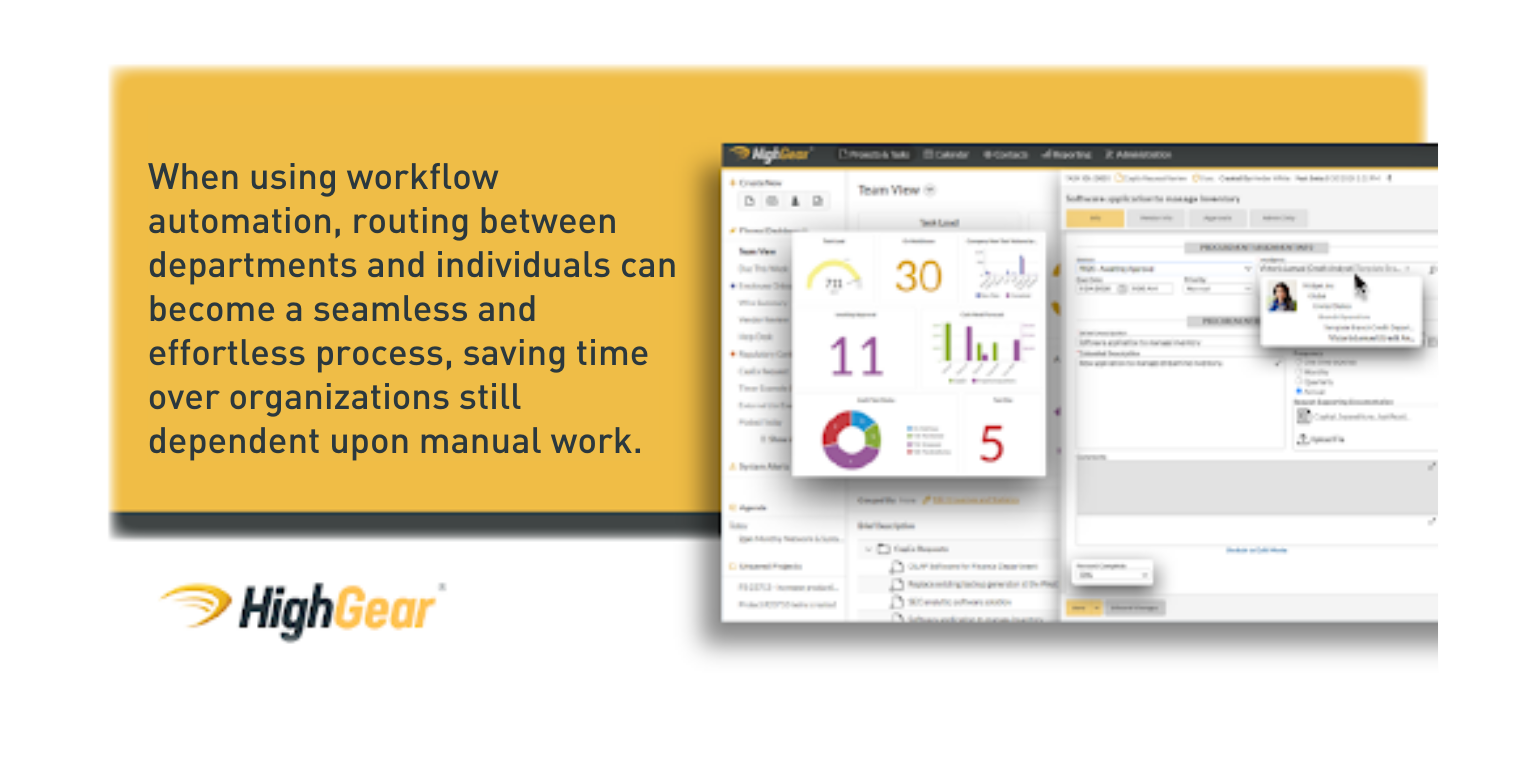
Today, technology is everywhere. We are constantly influenced by the technological advancements of the past decades, even if we aren’t thinking about it. Checking the weather on a smartphone or smartwatch, electric cars, and even scrolling through Facebook and Linkedin for hours are all digital technology activities that many of us take for granted. But with all of these advancements comes the need for adaptation. Because technology is evolving so rapidly, businesses are constantly needing to adopt new systems to remain competitive. And the term for this phenomenon, Digital Transformation, is as common in news and literature as reports on the weather suggesting it can’t be ignored.
Given this new age — one that we’ll refer to as the digital revolution — adopting new business models, software, and systems that help your organization increase revenue and efficiency is a paramount activity. It also requires a new mindset, corporate culture, and willingness for business leaders and everyday business users to embrace change.
True digital transformation for a business is not just about implementing new digital tools and hoping for the best. The key to a properly instituted digital transformation is embracing a full corporate or department makeover — one that encompasses all areas of the business. This complete remake leads to a fundamental change in the organization. This will not only introduce new and innovative technologies to the business but also help to optimize and reengineer it. If not done properly, many may wind up like traditional brick and mortar retailers, for example, who have been known for implementing the latest and greatest e-commerce technologies for their customer-facing activities yet leaving their employees working with 20-year old tech.

Why Digital?
As society continues to progress towards a digital world, the need for businesses to adopt and embrace a full transformation to stay relevant is increasing. This idea is not a new concept. And while it has been popularized in the past few years because of the effects of the pandemic, our society has been trending towards more digital avenues for a number of years. The increase of social media, for not only consumers but internal communications and marketing strategies for businesses as well, has greatly influenced the way that we interact with one another and played a significant role in the shift to “all things digital”. Even the healthcare industry has been revolutionized with virtual doctors visits and huge data sets to help predict and prevent the spread of disease. No matter the industry or application, it’s clear that we are in the age of digital transformation and undergoing a tech revolution.
According to a survey conducted in 2013, 78% of respondents said that “achieving digital transformation [would] become critical to their organizations within the next two years” and 93% of employees felt that a digital transformation was the right progression for their companies. This was almost ten years ago. Since then, we have seen a continual increase in technological advancements and usage — from smartphones and ‘smart’ homes to the internet of things (IoT) and online dating apps. To keep up with our society’s ever-changing technology, embracing new and innovative digital adaptations is essential to continuing progress as a business. It’s not only trendy but imperative.
Digital Transformation Benefits
Consumer habits are changing along with the evolution of technology. As social media and advanced tech become more available and more popular in the common sphere, consumers are becoming increasingly more tech-savvy and demanding more from businesses. For this reason and to stay competitive, businesses are needing to embrace new digital initiatives. Not only that, they need to employ people who can dig into data analytics and track specific metrics to improve and measure their results. Whether that means developing digital marketing campaigns on YouTube, TikTok, or Amazon, or creating visually appealing graphics that appear on consumer feeds via social media platforms, businesses are having to embrace the technologies of the public to stay top-of-mind with customers.
According to a study done in 2018, digital transformation “can lead to many benefits for organizations which includes improving organizational processes, reducing the costs of products and services, gaining a competitive advantage, and improving the customer experience”, among others. Here, we will delve deeper into each of these four benefits and more.
Drive Operational Efficiency
Embracing digital transformation means embracing a complete organizational change. It can help a company completely redesign and optimize its structures to more effectively reach and interact with customers and even achieve lofty goals like sustainability initiatives. The Harvard Business Review recognizes four tiers of digital transformation — the first two of which focus on operational efficiencies.
The first tier is simply embracing and creating operational efficiencies in a business by using data and artificial intelligence (AI) technology. The second tier, “advanced operational efficiencies,” is still utilizing data and optimizing production from that data. However, this tier is using information that comes directly from their customers’ use of their products and services.
The increased business performance that can be seen across many companies’ digital transformation journeys is in part due to this emergence of interactive data — as opposed to traditional episodic data. Not only can interactive data serve to greatly increase a company’s efficiency by providing continuous insights, but this “interactivity reverses the roles of products and data”.
Today, products serve not only as functional, brand-building, and revenue-generating creations but also as a means of collecting new information and representing new customer experiences. The data collected from these products can then be used to inform key decision-makers so they can make large-scale organizational changes and improve products and services – continuing the circle of business performance improvement.

Lower Operating Costs
Alongside operational efficiency comes the lower cost of execution. By digitizing certain aspects of a business, for example in the manufacturing of a product, a company can greatly reduce the necessary cost of creating new offerings.
Another aspect of digital transformation that is driving value relates to cloud technology — which has helped many businesses see a great “reduction of expenses, technical staff and efforts,” according to a study from the Trakia Journal of Sciences. Additionally, cloud computing provides businesses with access to some of the best technologies without them having to incur new expenses. And companies only pay for what they consume, rather than spending on the maximum possible use.
Above all else, digital transformation accrues recovered time. Teams can then invest more of their day in high-value activities that elevate the business, becoming more strategic along the way. Overall, advancements in technology and digital transformation help reduce the overall cost of operating businesses while still improving their efficiency. This ultimately yields higher profits and better business performance.
Create A Competitive Advantage
So, how do we look at a competitive advantage, and how can companies gain these advantages by undergoing digital transformation? One study from 2018 describes competitive advantage as being related to a company’s “ability of skillfully distancing and distinguishing [itself] from competitors.” Using this definition as a basis, a competitive advantage is more or less anything that helps to positively distinguish a company’s product or service from those of its competitors. In short, competitive advantage is anything that gets customers to desire that company’s products or services over another company that provides similar products or services.
But how can digital transformation help companies gain an advantage? The reality is that many businesses are struggling with competitive pressures and remain focused on product features rather than the customer experience. So when organizations learn to be more process-focused, they are able to assess what kinds of operational and service improvements are needed to deliver differentiated experiences for their audiences. And through a better customer experience, organizations will likely learn much more about product/service features that need to take priority, how to best price their products in the market place and what kind of value is desired to create “stickiness” with customers. Achieving all of these can result in capturing greater market share, accelerated growth, and improved margins.
Why Else Improve The Customer Experience
As the public continues to advance technologically, they are simply expecting more in terms of good customer experience. From quick response times to questions, concerns, and cancellations, to augmented reality applications that allow the customer to try a product before they buy (think beauty products and testing paint colors in your own home by virtually painting the walls), businesses need to ensure that their customers are satisfied or risk losing them to a competitor. This is why, as stated by an AIS Electronic Library paper, “improving customer experience has become one of the most significant motivations for organizations to implement digital transformation projects.”
While consumers will rave about an excellent product, a poor customer service experience can turn those 5 stars into digital mud. Yet, companies with inferior products but superior processes for quickly resolving issues and improving their product based on feedback position themselves to win in the marketplace. For example, you have likely experienced buying a 4-star product and you did so due to reading about how the company consistently resolves issues.
Because many industries are highly competitive, simply making the effort to connect and collaborate with customers can be what sets one company apart from the rest. This change of focus is difficult to do, but embracing digital transformation can help the company to understand and manage customers’ continually changing behaviors and information so that they can better continue to serve their customers.
Also, keep in mind, that the company that rescues its employees from administrative tasks through digitization gives them the time to personally interact with customers and learn more about what they wish a vendor could provide. Getting your employees to think strategically by having them move away from managing trivial tasks and processes elevates the entire organization.
Get More Done in Less Time
Transitioning to a digital system can help your business cut down on the time it takes to create content, applications, products, and other tasks. Alternatively, restricting the use and/or adoption of new technology in your business forces your employees to spend more time working with less to show for it. According to a survey of over 1,000 employees, 53% stated “they would be more empowered to better manage workflow if they were provided the needed tools,” and 42% stated that those tools would both “speed up boring tasks,” and “result in better work morale.”
Digital systems offer tools like automation — which allows your business to get time-consuming, lower-value activities done through a work management platform, ultimately cutting down on the time employees need to devote to them. This not only helps your teams be more productive on other value-added tasks and processes but also reduces the number of errors that result from things like manual data entry. When using workflow automation, routing between departments and individuals can become a seamless and effortless process, saving time over organizations still dependent upon manual work.

Increase Revenue
The increased revenue that businesses see when they embrace digital transformation goes hand in hand with the lower cost of operation and the increased productivity that digital systems provide. Because the overall cost of operation is lowered, and businesses are able to more quickly produce and deliver products and services, the overall revenue of the business is bound to increase. As the Trakia Journal of Sciences paper states, companies that reported that “big data, cloud, mobile, and social technologies are critical parts of the infrastructure… had higher revenues, and achieved a bigger market valuation.”
Real-Time Visibility
As society continues to move towards the digital sphere for entertainment and commerce, the amount of data pouring in continues to increase. While there is a lot to sort through, making sure to pay attention to the data coming in is extremely important in helping you to understand your customers better. Harvard Business Review notes that continually progressing technologies — such as predictive analysis and AI — can help provide companies “comprehensive supply-chain visibility with real-time data”. This allows businesses to make effective and timely decisions that are mindful of changing market dynamics. Real-time visibility of incoming data and across processes can help your business make informed and data-driven decisions rather than having to rely on estimations or trends.
Few organizations have sufficient visibility into their human-led process performance. Many have an easier time accounting for whether or not paper clips are being used efficiently vs. how human resources are being deployed — despite the dramatically higher cost of human labor. Digital transformation, when applied to the management of work, can provide breakthrough insight in this previously opaque area, leading to some of the greatest possible return on investment (ROI) a business can realize.
Better Control of Data and Information
Finally, and possibly most importantly, digital systems allow businesses more control over the data and information that your organization needs. As mentioned in a Forbes article about data in the age of digital transformation, this increased control allows organizations to more effectively “leverage the value of their data to unlock new opportunities,” and insights.

Because digital systems offer you immediate access to any information or piece of data that you need, embracing digital transformation can help your business more efficiently put information in the hands of the people who need it. This not only reduces the amount of time spent searching for data when it is needed but also helps to facilitate a broader intelligence among key stakeholders.
The ease of access to information and real-time data offers your employees the tools they need to make better and more informed decisions. This not only helps to keep your employees focusing on more productive tasks (rather than tracking down needed information) but also dramatically lowers risk for the organization. If employees and managers are provided with the information and data they need to carry out their work, they are much less likely to make mistakes or cause issues that will need to be addressed. Data-empowered managers will foresee when they will need additional staff and have the request in before the customer experience is even impacted.
The All-Digital Company
We have detailed above many of the benefits of implementing digital transformation in a company, but how can a company successfully embrace it to reach these benefits? Achieving a successful digital transformation can be difficult. As Harvard Business Review comments, many businesses can act under “the naive assumption that by simply buying technology — or investing in any of the fancy tools or shiny new objects of the booming tech market — organizations will somehow transform.” Unfortunately, achieving a successful digital transformation requires more than just spending money on new technologies.
Digital transformation is a complete organizational transformation of a company, and without a solid strategy put into place, rushing into new technology can cause many problems. Successful digital transformations can only occur with “well-founded strategy and leadership,” as is noted in the 2017 Trakia Journal of Sciences paper. So while embracing new technologies can provide a company with a surplus of improved capabilities, in order to fully achieve a digital transformation, the company must work on changing and optimizing itself as a whole.
If you are ready to improve your business and gain advantages over competitors, improve your customer experience, and optimize your efficiencies, all while lowering your overall cost of operation and risk, then get ready to embrace your digital transformation. You may even want to consider deploying HighGear where our software helps you build high-tier workflow applications without writing any code! And in just days, you can be up and running quickly as our visual platform allows you to easily create and deploy workflow applications, improve visibility, and streamline your operation.
HighGear also keeps security and integration as our topmost priority so that you can rest assured your data is safe and easy to connect. Whether you have already been implementing changes in your company to stay competitive or you’re looking to start now, HighGear’s incredibly user-friendly platform can help you achieve a successful and smooth digital and ROI revolution in the area of work management at scale.
